Automakers screwed up the market for decades with price increases and going upscale. Now they pay the price with dismal volume.
By Wolf Richter for WOLF STREET.
Total new vehicles delivered to retail customers and fleets (dominated by rental fleets) in the US in 2023 rose by 12.4% from the dismal levels a year earlier to 15.46 million vehicles.
The two best years were 2000 and 2016, with 17.4 million and 17.5 million vehicles sold. In 2023, sales were about 11% below the 2000 high and 11.6% below the 2016 high. And compared to 1986, sales were down 3.7%, and compared to 1985, sales were flat. That was nearly four decades ago! Over the same period, the US population has increased by 40%!
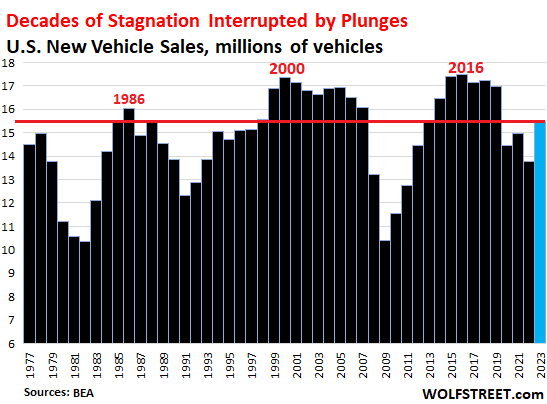
Screwing up the market with price increases and going upscale.
Turns out, after decades of price increases and going upscale to maximize revenues and profits, automakers have created a market in the US where the average American can no longer afford a new vehicle, and they’re buying used vehicles – financially, a good strategy.
Automakers have thereby screwed up the US market to where new vehicle sales are languishing in the best years and plunging in the bad years.
Full-size pickup trucks are a great example of price increases and going upscale. There have been only four automakers that sell a high volume of full-size pickup trucks in the US: GM, Ford, Stellantis, and Toyota. Nissan will discontinue its Titan in 2024 due to low sales. Two new players are now entering the market, still with small numbers, Rivian and Tesla.
So, for now, four companies are selling full-sized trucks in volume, with huge price increases year after year, and grotesque profit margins, a testimony of oligopolistic pricing behavior.
We here at WOLF STREET have developed our own new-vehicle price index based on the bestselling truck, the Ford F-150, and the bestselling car, the Toyota Camry. We discussed this and our notion about the pickup truck oligopoly here. And for your amusement, this is the chart – since 1990, the MSRP of the F-150 XLT has shot up by 267%, including a spike of 39.4% from 2020:
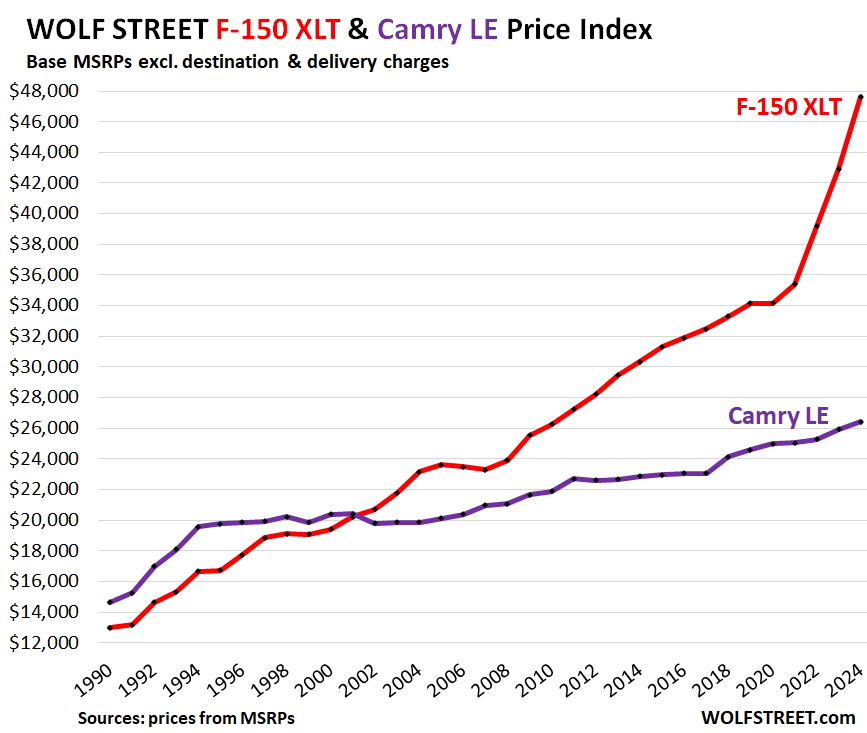
The average transaction price including all incentives, discounts, and addendum stickers had spiked by 36% during the pandemic, from $34,900 in December 2019 to an absurd $47,300 in December 2022, according to JD Power data.
Then in 2023, inventory was back on dealer lots, and discounts and incentives were piled on, and most of the odious addendum stickers vanished (if you see an addendum sticker, “just say no”), and by December 2023, the average transaction price had dipped by 2.7% to a still absurd $46,055:
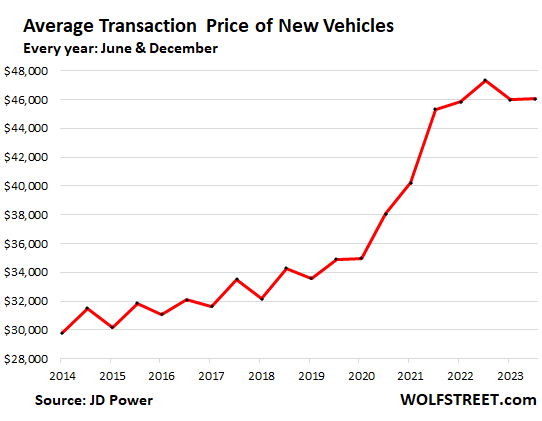
The biggest automakers in the US.
General Motors, #1: Sales of all its brands in the US in the year 2023 rose 14.1% to 2.59 million vehicles. But this was down by 16% from its recent peak in 2015.
Sales of GM’s Bolt and Bolt EUV, its old EVs, surged by 62.8% in 2023, to 62,045 vehicles. After the price cuts by GM, and after the federal tax credit, a base Bolt could be bought for just a little over $20,000. And there is demand for decent vehicles in this price category. But 2023 was the swan song for them, GM killed them at the end of the year.
GM is now launching several other EV models based on its new Ultium platform, but sales just started and are minuscule.
GM’s sales had dropped each of the four years before the pandemic. Then the semiconductor shortages wiped out its inventory. But in 2023, inventories were back to normal. You can kind of draw a mental line from 2015 through 2019 and then extend that line, and it comes out just a above 2023, which makes for an ugly trend.
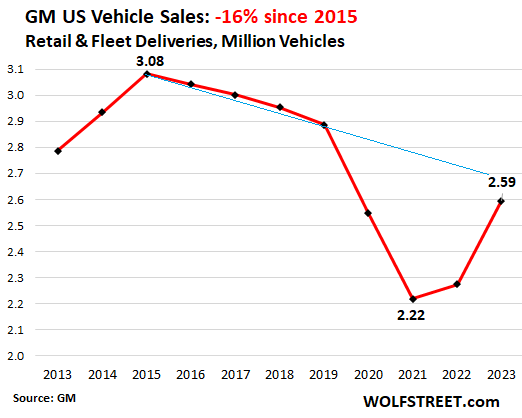
Toyota, #2: Sales of Toyota and Lexus brands combined in the US rose 6.6% in 2023, to 2.25 million vehicles. But this was down by 10% from its recent peak in 2015.
Toyota has no EV to speak of. A year ago, some lights went on and Toyota’s longtime anti-EV CEO Akio Toyoda was forced out and replaced by a new guy, Lexus boss Koji Sato, under whom Toyota is now trying to build an EV strategy.
The trend in this chart – that line from 2015 through 2019 and extended toward 2023 – looks just as ugly as GM’s:
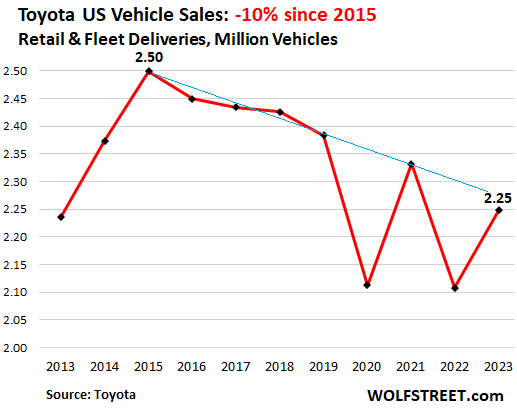
Ford, #3: Sales by its Ford and Lincoln brands combined rose 7.1% in 2023 to 1.996 million vehicles (OK, 2.0 million), after seven years in a row of declines. From the recent peak in 2015, sales are down 23%.
EV sales rose by 17.9% to 72,608. This includes a 54.7% jump in sales of the F-150 Lightning, to 24,165 trucks. Tiny startup Rivian has thereby blown past Ford’s electric truck sales. That’s how good Ford is at selling EVs as it’s now busy staring down an anti-EV revolt by its dealers.
Interestingly, in Q4, sales of ICE vehicles and hybrids dropped 0.4% year-over-year, while EV sales surged 27.5%. The surge in EV sales caused overall sales to rise 0.8% in Q4 year-over-year. Without EVs, overall sales would have declined 0.3% year-over-year.
Ugly, ugly, ugly. I’m not even sure where to draw the mental trend line. But hey, Ford is blowing billions of dollars on share buybacks:
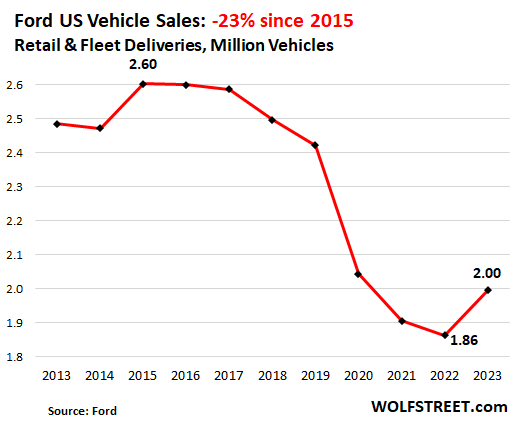
Hyundai-Kia, #4. Hyundai is the parent company of Kia, with Hyundai holding a 33.9% stake in Kia, and Kia holding stakes in Hyundai subsidiaries, and they share vehicle platforms. So for our purposes here, we look at the duo as one automaker with different brands.
And they’re rocking and rolling. They surpassed FCA US (Stellantis) in sales in 2023 for the first time. Year-over-year, sales rose 11.7% to a new record of 1.58 million vehicles (Hyundai 801,195 and Kia 782,451).
EV sales: Hyundai’s sales of Ioniq EVs soared by 76% to 46,917 vehicles. It also sells an electric version of its Kona crossover, but didn’t separate out the sales of the electric version (all Kona sales totaled 79,116). Kia’s EV sales dipped 2% to 19,997 vehicles.
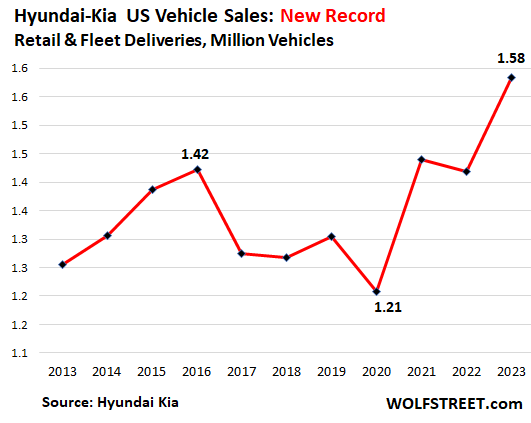
Stellantis #5: Oh dear, FCA US sales dropped another 1.3% in 2023, to 1.53 million vehicles. From the recent peak in 2015, sales have plunged by 33%. FCA US was surpassed by Hyundai-Kia for the first time, after having been surpassed by Toyota years ago.
It’s not mass-producing any battery-electric EVs, but it’s mass-producing announcements about them. The first EV models are supposed to trickle out by the end of 2024, it said.
In terms of ugliness, the trend in this chart is in a category of its own, speaking of an existential crisis:
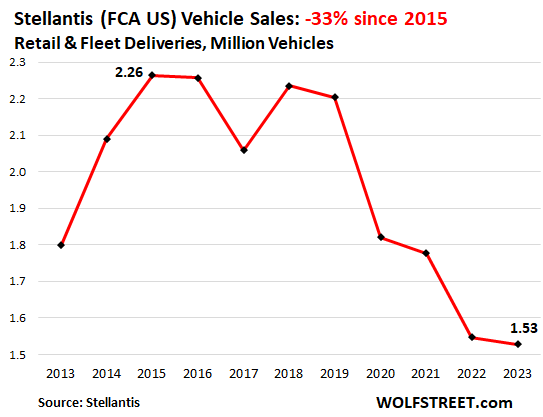
The big three US automakers? GM, Ford, and Stellantis are the big three US automakers, or what remains of them. Toyota is #2 in the US, and it manufactures vehicles in the US, but it’s a Japanese company, so a foreign automaker. Hyundai-Kia is #4 in the US, and ahead of Stellantis, but it is a foreign duo, though they manufacture cars in the US. Stellantis is a European company that bought FCA US, but for whatever reason, we still consider FCA US a US automaker, though FCA US imports a lot of vehicles. So the lines are getting blurred.
We now have a fourth US automaker that isn’t that big yet in terms of US sales, but has been getting bigger fast: Tesla. All its vehicles that it sells in the US are made in the US – unlike the other US automakers. So now, we’re needing to talk about the “big four US automakers?” Or the big three, with Tesla in and foreign automaker Stellantis out?
Tesla doesn’t disclose US sales. It only discloses global sales. But there’s the registrations data. Per registrations, the Model Y has become the #2 bestselling vehicle in the US, behind the F-series truck. But registrations data lag. And we have them only through Q3 2023.
Tesla’s global deliveries in Q4 rose by 11% from the prior quarter, and by 20% year-over-year. For the whole year, they rose by 38%. We can estimate Q4 registrations in the US based on some modest growth from Q3, and that’s what we have done here, not super-accurate, but close enough?
We added a modest amount of growth to the first three quarters of 2023 (registrations data via goodcarbadcar.net) and came up with something close 680,000, give or take. So this is far smaller than the other US automakers. It’s less than half of Stellantis’ collapsed sales.
But Tesla’s sales are going in the right direction, having surged from practically nowhere a few years ago. And so I include them in this annual discussion here for the first time. Tesla has arrived.
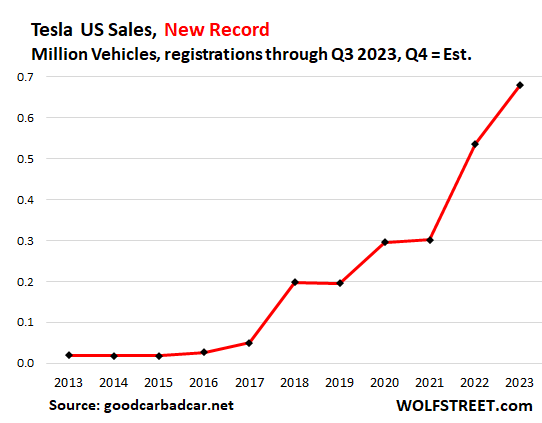
Honda (American Honda Motor Co.) sales jumped by 33% from the collapsed levels in 2022 when it ran out of inventory due to the semiconductor shortages. Compared to the peak of 2017, sales are still down 20%.
Like Toyota, it totally dropped the ball on EVs. And for 2024, rather than developing its own EV from ground up, it will offer an EV (Prologue) based on GM’s new Ultium platform, coming soon to a dealer near you.
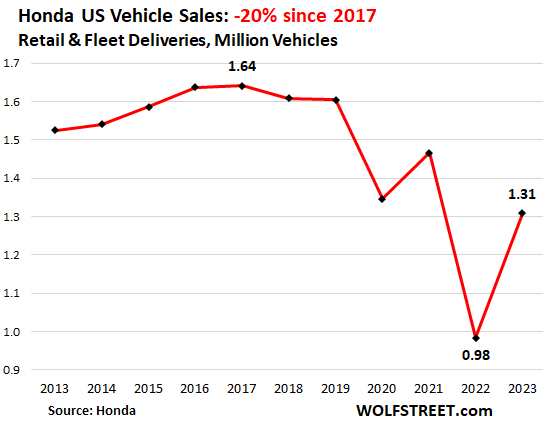
Nissan: Sales of its brands Nissan and Infiniti combined rose 23% to 898,796, but were still down by 44% from the peak in 2017. Existential crisis in the making. Ugly, ugly, ugly:
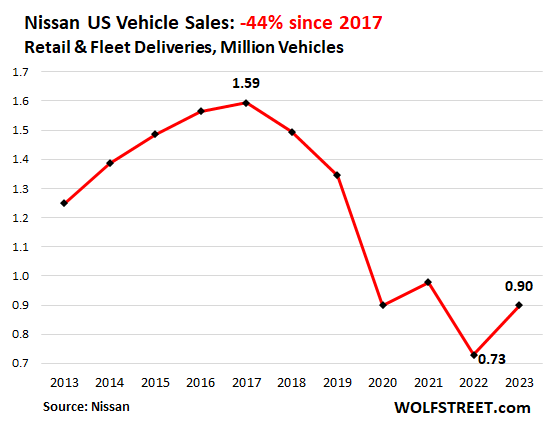
Enjoy reading WOLF STREET and want to support it? You can donate. I appreciate it immensely. Click on the mug to find out how:
![]()


Not a bad thing to sell less cars for bigger profit. Less junk on the road is good for environment too. Transition to EV probably kills a big percentage of the demand for the Detroit 3 permanently.
I am curious how the German makers faired. They can’t feel good given competition from Tesla.
They’re small here. Don’t measure up to the big ones.
“But 2023 was the swan song for them, GM killed them at the end of the year.”
It’s my understanding the GM has committed to bringing an Ultium-based Bolt to market.
Yes, a completely different car with the Bolt nameplate, sometime in the future, no arrival date. Could be years.
It’s good for whom?
With population increase out the wazoo, & fewer citizens able to buy, no public transportation to speak of….sounds like more homeless to me.
Good for the manufacturers, sex for America. Bidenomics once again. Fools
so my daughter(22) just graduated university in dec.
lover her ford expedition(2016) she had as she regularly carried many teens as teen leader at church.
now that she has to pay for everything, she wanted newer better mileage car – ended up with 2020 Kia sportage – they wouldn’t discount newer ones
she got $17k for expedition – dealers offered $13k
and paid CASH FOR CAR
btw we didn’t pay for her tuition/books and she worked/saved
can’t teach that folks
Maybe she can teach Dad how to use the caps button at the very least?
Tesla is a concern in Europe, but the bigger problem is the Chinese. BYD (for example) outsells Tesla and I’m seeing a lot of them. And their advertising is everywhere.
One of the big problems is that, in Germany for example, the auto manufacturers are owned in part by both the unions and the local governments, neither of which is prepared to sacrifice jobs for “green” initiatives. EV’s require a lot less labor, parts, and support, and with AI and robots also competing for what will be fewer jobs the companies are between a rock and a hard place. They can’t just lay off workers (it’s against the law), but they can’t afford to keep them and stay competitive.
And if you think a car is expensive in USA, take a look at the price of a BMW in Europe. When you have to sell cars at $80,000/each just to stay in business, and the competition can sell one at $20,000 (like BYD), you have a big problem.
BYD Burn your domicile?
You can’t seriously think BMW & BYD are appealing to the same consumer?
BYD started by copying Toyota. At least compare apples-to-apples; Anything $20,000 from BYD is targeting the commodity import car import manufacturers, not the luxury domestic (for Europe) car makers.
I’m on strike for buying a new vehicle until they come up with an autodrive that works. Home James!
I was kinda the same way. But then our vehicle got totaled (rear-ended by a human driver). And now I hafta wait another decade for my robo-driver. I see the driverless Waymo thingies out there though, looking pretty snappy.
I really hope they get it running. The roads around here will be LOADS safer! Musk thinks he can do it with real time photogrammetry processing only, minus the lidar but I’m gonna have to ask my industry buddies about that. I’m aiming at electric for the town car thing and hold a liquid fuel for longer trips maybe. Meantime the real world troubleshooting going on should help expedite matters. :-)
Musk has been promising “self-driving” every year since 2014. At some point, even the die-hard fans will figure out he’s just pulling nonsense claims out of his ass.
I’m not in the industry, but Musk’s obsession with “humans drive only with their eyes” is not only wrong (we listen to sounds, and feel road conditions) … but misses the larger point: if humans’ biological abilities were the pinnacle of transport, we wouldn’t be building cars.
Obviously self-driving cars should use radar, lidar, infrared, wifi, etc. etc. whatever improves their ability to observe the world.
Don’t hold your breath. As challenging as the technical aspects of self-driving cars has been and remain, they pale in comparison to the regulatory and insurance hurdles.
Jets have been flying millions of people on auto pilot for years
Wake up it’s coming. Here is south Florida we have so many human error accidents body repair shops are backed up 6 months. FSD IS GOING TO BE A HUGE LIFE SAVER to many idiot drivers on the road and it won’t take much for FSD to beat this
The car manufacturers are in a bit of a bind, however. Because of large sunk capital costs, they need to see significant, major cash flow. This creates the temptation to raise prices on their primary offerings. Unless there is blowback from the consumer, in the form of their deserting the manufacturer for other options (used cars, et al.), the car manufacturer will not be able to heed signals from the market.
It is the tone deafness to SIGNALS which is the basis of the problem.
The conglomerate car dealer in my area lots are full now there overflow lot is filling up this will end badly people have a long memory I hope they rot in hell thieves manipulated customers now it’s payback time
I am seeing that here too. The lots are full. If you’re looking they will contact you every hour. These really aren’t Luxury cars, but they want a luxury price. Who’s rushing.
Wolf you said correctly that 2/3rds of used car buyers pay cash. How do they accomplish this?
I mean they save up until they can do a cash deal at the local slick haired used car lot? Do they have bad credit? Who would fork over so much cash when Bank of America would make you pay just $200 a month for a Corolla.
This really boggles my mind… if you might break it down. Thanks!
Everyone I know who buys used vehicles, including us, pays cash. They buy something for $5k for their kid, and they want to relegate the old truck to towing the boat and going hunting, so they buy a 2-year old car for $20k, and pay cash. etc.
American consumers are loaded with cash. I wrote a bunch of times about the trillions of dollars they have in CDs, bank accounts, money market funds, T-bills etc. This will give you some numbers:
https://wolfstreet.com/2023/11/24/money-market-funds-large-cds-small-cds-all-surged-americans-figured-it-out/
Having 3% mortgage also helps. These banks holding low interest mortgages must feel pretty bad right now.
I never let dealer know that I am paying cash. Wear your worst clothes, get the price down, and when they finally ask you to the credit dept, drop it on them, and watch their face. Kinda fun. And send the savings to your favorite blogger….
They always ask you at the beginning whether you are financing or cash – what do you say to this question?
good start dz:
also, bring a friend and coach them to join you as you leap up and move toward the exit and say something like you knew they wouldn’t ”deal”, etc., etc…
has worked for us every time, including the time we bought a new 3/4T for a bit less than half the MSRP
jack: you say “let’s worry about financing after we’ve found a car I want to buy”.
pro-tip: it’s legal to lie about your intentions to car salesmen. Go ahead and tell them “I plan to finance through your credit department” just to get them off your ass, if you feel like it.
It’s the farmers buying new equipment with $200k cash that gets me, but I guess with that business you need a sizable bank account just in case
Don’t forget…the farmers get big government subsidy checks. I am not saying they don’t work hard but name another job where the government will underwrite your risk using tax payer dollars? GM aside…lol.
GM got a Government loan. With an interest rate attached. And paid it back in full. A great business deal to keep them afloat and their workers employed during a financial meltdown caused by Wall Street. Remember the Big Short?.
And the loan was made by the Obama administration. Yielding bonus profit on the loan for the Taxpayers. That would be you.
Don’t re-write history to suit your politics.
What bajarefugee said. As for US farm subsidies, have you forgotten why America has those, or has the state of US education become even more risible than even snotty foreigners such as myself assume it has always been?
eg – sadly, it is. Objective U.S. Citizenship and History emphases don’t seem to make it into the contemporarily prevalent ‘3Rs’ thinking (or STEM for that matter) any more than the Arts&Letters do…
may we all find a better day.
Only a moron would borrow at 6 or 7% to buy a depreciating asset, who cares what the “monthly payment” is, savers plan ahead and don’t pay interest.
We’ve always paid cash. My husband trolls the £2k to £4k market. It’s hit and miss and we’ve had to replace brakes tires and old stuff that just breaks, but so far we’ve not been burned, considering they’re deprecating assets anyway
Ok sufferinsucatash, lets run a scenario. You manage to find a base model Corolla for $22,000. You put 20% down, $4,400, for a finance amount of $17,600. Lets also assume you have really good credit and can get an interest rate of 7%. To get to a payment near $200, you would need a 10-year term (good luck getting that on a Corolla) for a monthly payment of $204.35. After 10 years you will have paid the original $17,600 plus $6922.11 in interest, or about 30% of the car’s purchase price. So you have paid $28,922.11 for a $22,000 car. Does that seem like a good deal to you?
Close… in 10 years, a $22,000 car will probably cost $28,922.11.
The Store sells bottle of Gatorade for $2 and makes profit. The gas station sells smaller bottle of Gatorade for $3.75. My only advice is don’t buy.
Actually, don’t buy any of that crap including gatorade. Drinking water out of the tap has served me well for 8 plus decades.
You might want to have the tap water tested for BPA, heavy metals, PFAS, and the list goes on. Unless the water out of the tap goes through a reverse osmosis system its likely the water is not much healthier than a manufactured can of carbonated sugar these days.
At least there is no sugar in tap water.
Now it has fire retardant laced pfas tho
Look into reverse osmosis
In beer there is strength. In wine there is wisdom. In water there is bacteria OR other ”stuff”.
These days, if not filtered at home, etc., tap water MUST contain ”stuff” MANDATED by the US GUV MINT if the municipality gets any money from feds.
Easy to look up, as every municipality must publish analyses of their public water regularly, also mandated by feds.
thats not how it works.
everything that’s in water is also in beer.
Just an FYI: people used to get sick or die from drinking water that hadn’t been boiled, and in some places they still do. So water that comes out of the tap and doesn’t make you sick or kill you is one of the big health events in human history.
Congrats, Louie. 8 plus decades is testimony to the fact that water works (not the utility on a Monopoly board).
I got a 2005 Lexus ES330 with 110k miles. I’m gonna drive it another 100k. Purchased for $11k in 2014. Still runs like the day I brought it. Maybe it’s just me but I don’t see the obsessions with buying new cars every other year!
Yes, there’s that too. Vehicles last a long time these days, and when taken care of, look good for a long time.
“..and when taken care of, look good for a long time.”
Much much easier on the west coast. Out on the east, I guess NE for Americans, any area that uses salt in the winter makes it very tough. Rustproofing helps a lot, but if you can’t hide your car away for the season it will get eaten up. However, the bar for what “looks good” is also different, so well maintained cars do look good for a long time, just don’t bring a well maintained east coast car out west, it loses up to half it’s value that way, at least mine did 😆
When evaluating off lease returns, we would use a term called “CA” (commercially acceptable) to describe vehicle damage.
On the Left Coast, anything larger than a minor door ding was deemed not “CA”. On the East Coast? Any damage smaller than a league baseball made the cut.
If you’ve ever worked on your own car and lived in the road chemical laden or salt water states, you’d be amazed at how pristine a 20 year old car from the dry areas of the west are. There’s little to no rust on any of the running gear and the aluminum pitting/corrosion is non-existent.
Road salt should be banned across the US. Oregon, for example, gets lots of snow but uses cinder, gravel, and sand versus salt. Drivers learn to take it easy. Salt and other snow removal chemicals are bad for our vehicle investments, our health, and the runoff is terrible for rivers, streams, and the environment in general. I wonder what happens when salt corrosion starts to attack EV car safety systems?
I feel this has to be a significant part of the decline. Vehicles are just much better made than they used to be. I remember in the 70’s a vehicle that was 10 years old and 100k+ miles was ready for the scrap yard. Now it seems getting 200k+ miles on a vehicle is normal.
Those Hondas and Toyotas from the 80’s put some serious pressure on the big 3 to improve.
Not all vehicles are better, My daughter who owns a fairly new Audi just spent $C2500 replacing front springs made of Chinese steel. Mechanic said everyone except North American manufacturers were using Chinese steel to save a few dollars on a $60K car. Fewer repeat customers on the horizon.
I remember my father’s cars in the 1970s would have to start repairing the rust holes on the fenders and the rocker panels after 4 years. They went to the scrap dealer after 7 years.
Kia and Hyundai are way ahead of the US car manufacturers with EVs. They’re producing reliable, well made ones that get approximately 300m. per charge, likewise with Tesla and a whole slew of Chinese EVs that aren’t allowed to be sold in the US, yet. The whole ICE market is soon to be a thing of the past and both Japan and the United States manufacturers are in real trouble.
Except these 2 brands are stolen A lot. A news story just popped up on our local Raleigh station. Some lady was in Cleveland and her Hertz (subsidiary) rental was stolen with a Tik Tok hack/ challenge. Hertz stonewalled her, banned her from ever renting from them again. So she went to the old “5 on your side” news team journalist who contacts the company for you.
Apparently they had already recovered the vehicle without letting her know. And charged her 3x the charges. The news station fixed most of it for her. Gotta love the fear of bad PR.
The issue with theft is a historical one. Hyundai stopped making vehicles that have the vulnerability that makes them easy to steal more than 3 years ago (and even then it only affected some of their models, not all).
This is America…who let’s the truth get in the way of a good media moment?
Big issue in SF East Bay… I hear there’s a Kia Boyz gang, possibly responsible for the Kia, and Hyundai thefts?
I have a feeling that where we are heading is not 5000lb, 3 sec 0-60 EV’s but those three wheel Tuk Tuk things they use in India.
They are already selling them here in Honduras. They come with a 4 wheel option now too. The ones here are made by a Bolivan company Quantum.
Mr. Bond, I presume?
Wolf strokes his white cat. ;) hehe /s
Saw many of those in Cuba of all places where gasoline is scarce and power not available much at all as well.
Visit New York City lately? It is starting to look and feel like Vietnam with all of the scooters and motorbikes zipping in and out of traffic, ignoring traffic laws, etc. The cities push for bike lanes and lack of regulation on types of unlicensed vehicles and where they can and cannot be used has turned most of Manhattan into an even bigger. Coupled with a police force that could give two shits and you get the picture.
In my opinion, much of Hyundai’s growth is a function of the extreme inventory challenges of Honda and Toyota over the past couple of years.
Only in the past couple of months or so Honda has managed to bring its inventory back to reasonable levels, while Toyota has gotten a bit better but still has work to do. As these two finally recover, I would expect Hyundai’s growth rate to slow down some. Kudos to Hyundai though for taking good business advantage of the situation (especially given that Honda and Toyota owners pretty loyal to the brand and now Hyundai has a chance to draw in those customers). Anyway, that’s how the marketplace is supposed to work!
Kia/hyundai are redesigning their cars and jumping to the front of the consumer reports ratings. They now have the highest rated large SUV and minivan. When I wanted a minivan last year it was a no brainer to get the kia with the high ratings AND 10 year warranty.
They must have invested a lot to do this. The others seem to be putting everything into EVs and letting their older vehicles get outdated.
KIA is all about reliability. Bought my first one in 1994 (Europe), when everyone thought this was a piece of junk. I drove it for 25 years, never had a significant problem with it. Now they are even better, although I’m not a fan of all the gadgets in new cars. Cars should be cars, not the Enterprise.
KIA is all about unreliability you must have gotten the only one that wasn’t a lemon.
Absolutely. Hyundai made a highly concerted effort to transform the quality of the vehicles over the past couple of decades.
I am not sure I agree with your second paragraph though. Honda and Toyota have only made token moves towards electrification. Toyota especially is well known for being called out by the EV fanboys for how little effort it’s made towards electrification.
KIA/Hyundai initial quality is good however their long term is questionable. They’ve had a spate of problems with their engines. My buddies Sorento engine died, KIA wouldn’t honor their 10 year warranty so he had to pay out of pocket to replace the engine. (I know anecdotal)
Kia has or had massive problems with their gasoline direct injection (GDI) systems, which can ruin motors.
Hyundai’s 10 year warranty isn’t worth the paper it’s written on. They take the hardball scare tactic strategy of insinuating that they will probably find evidence of neglect during the repair so you better be ready to pay up. Scum bag dealers. I don’t really ever make negative comments on WS, but Hyundai inspired my eternal rage with the way they treated my daughter when her GDI engine crapped out. Afterwords, upon telling the story, others have told me they they had the same experience.
Fantastic article and charts. I wonder why they (automakers) can’t enable their research departments to figure this out. We are late model pick-up people ourselves and will never pay the inane mark-up for a new one. Just stupid.
Howdy Folks. New vehicles are great and a better way to go. Exactly what was purchased for my 2 teenage sons years ago. They each kept their vehicle till married and living on their own. Take good care of a new vehicle and it lasts a long time…… Always pay cash for cars also. Unless the interest offered by the manufacturer is less. Before ZIRP, and in the olden days, they would have incentives from the manufacturer instead of Govern ment to get at your spending $$$$…..
ZIRP ruined everything.
Swamp’s view on the state of the US car market
U. S, carmakers have gotten greedy and decided to build upscale fully loaded cars that nobody wants, nobody needs, and nobody can afford. As a result, they will be going bankrupt, on by one starting with Ford and require a taxpayer bailout. As the charts above show, Ford is already in the intensive care ward. I just bought a basic no frills car, a Mitsubushi Mirage, and it gets me around town just fine. I Paid $11,600 for a 2020 car with 60K miles on it. I feels like a brand car, Got it off the rental fleet, and it was shipped here from Missouri. I noticed the lot where I bought it was filled with big American cars that nobody wants. They will be sitting there for months with no buyers anywhere in sight. Meanwhile the small imported cars are getting snapped up as there aren’t very many for sale.
Is this true or is it just an anecdote? Car manufacturers very much make the cars people want to buy, thats why a lot of domestic manufacturers got rid of small cars. Nobody was buying them. Does the market change over time, yes? Will they get stuck with inventory of ‘big American cars’ at some point?….perhaps. But i think you would be surprised if you knew the industry better. They literally build what people are buying. However markets change. But your idea of them going bankrupt with tons of inventory when gas prices are $3 per gallon or less seems a little wishful thinking. Just because someone wants a 100k Denali pickup and you do not, does not mean much. We need to not mix up what we desire vs what the average consumer desires. Too many people do that. I have seen it happen a ton with manual transmissions. There’s a reason they dont make them anymore.
The number one automotive theft deterrent device is a manual transmission.
🤣
About right.
“this vehicle is equipped with a millennial anti theft device”
Blake,
This response is total BS. Give me a break. I was told 1st hand by a major auto dealer here, and everyone knows, that they don’t sell small cars because they don’t make enough profit on them. They are low margin operations. They sell big, loaded up cars to maximize profits.
They’ve outsourced all of the small economical car production to overseas manufacturers. The lot I went to had 2000 big American cars that nobody wanted, and only few small economical cars. I believe my eyes.
Why do I have read this BS on this site all the time? I may have to take a break off of this thing for a few months to clear my mind.
Why do you think it’s BS that the car you want to buy is not the same as the **truck** everyone else wants to buy? Trucks sell, SUV’s sell, crossovers sell. The sedans do not. Car manufacturers were losing money on some models, so you are dang right that they’re going to make more trucks instead. They are short sighted and just want to maximize profits. That doesn’t mean they’re not making what people want. People want trucks. Do I think it’s stupid for OEMs to give up market share to foreign manufacturers during high times so that they can just sell high profit trucks in the near term?….yes. but that’s what they did. Stop thinking that just because you want a car, that everyone else does too. Everyone wants trucks and SUVs!!! So the manufacturers build them, and it’s one thing they build well, and make $$$ on. It’s not BS, it’s reality. Don’t get so mad about being one of the few buyers who doesn’t feel the need to drive an overly large and in efficient vehicle just to prove your worth as a man or look cool or prove status or…whatever. You are winning in the end. However, don’t blame the manufacturers for building what people have been buying indiscriminately. This may cost them in the end, but they’re making $$$ now. Blame Americans for loving trucks so much, if you want to blame anyone here… for not being able to find a domestic car.
I’ve been driving a 2017 mirage since 2018. I love that it’s cheap to insure and maintain and getting 40mpg is fantastic as I have been driving it all over the US the past 2 years.
I have been taking it on hiking trips and vacations, avoiding the airports because it’s cheaper and less of a hassle to drive my car.
I also got mine used from a rental fleet with 11k miles on it for about $12k
Get some snow tires if you live where it snows and I’d get some different tires than the recommended ones it comes with for general driving as well, as those tires seem to wear out extremely quickly.
I intend to keep my car for a long time. I love that it has no infotainment system, million sensors, cameras and other unnecessary crap that it seems all modern cars have now. It’s a simple, no frills car that is a good value for its price. It’s exactly what I want from a car.
Giving up market share just to make short term profits for a few years, is the stupidest thing a car manufacturer can do. It takes a long time to re-tool to build cars that may not be in favor now but would be for a time in the future when there is demand. The US car makers are stupid and dumb. When they all go out of business and their stock price goes to zero, I will not lose one night’s sleep. I haven’t bought an American car since 1978 when I wasted my money on a lemon Ford Mustang that was a piece of s$it if there ever was one.
This whole “car makers should lose money selling cheap cars for market share!” theory is long debunked.
This nonsense of “i bought a cheap ford fiesta 8 years ago therefore I’m going to ignore every other brand and automatically buy a ford escape today” is totally delusional
Car shoppers almost always research and cross-shop brands.
BMW has made and makes the best array of vehicles out there. I prefer the E38 and E39 cars from the late 1990s and love Oxford Green.
Still driving my 1986 Toyota Tercel wagon and 1979 VW camper van (Type 2). After reading this article, I just might look into the Hyundai EVs.
I heard recently that Chevrolet is bringing back the Bolt (v.2) EV, around 2024 – 25. Not sure I’ll wait that long, but that made my day. GM is still in the affordable EV sedan game!
They are planning to bring it back with the new battery arrangement ~2025. I have a 2023 Bolt EUV and love it. I follow the Bolt forums and “word” is the body will remain the same, size wise, and the improvements will be in the battery and electronics.
I was at my local Chevrolet dealer yesterday afternoon getting a free tire rotation and four NEW 2023 Bolt’s were being unloaded off a truck carrier. These must be close to the last of the 2023 production runs. The sales guy said they will be all sold by Monday as he has a wait list. All four MSRP’s were in the low $30K range. One had the SuperCruise option. Looks like GM will be selling near 70,000 of these this year (2023).
I don’t know what Mary Berra (GM CEO) is smoking, but why they don’t just keep making the current Bolt while they retool for the 2025 model is plain nuts.
Good luck getting a dealer to show you them. My son was looking for a new car, and I went with him to test drive their EV options. As soon as the salesmen heard we were interested in an EV they handed us off to their newest (and least experienced) sales person who knew less about the car than my son did. The sales guy spent the entire test drive talking about his next planned career move. Perhaps a three mile test drive and we were back at the dealership. “Thanks for coming, don’t let the door hit you in the ass on the way out!” We went from there to a Tesla showroom. They handed us a key card and said “try to be back in 30 minutes”. My son bought a Tesla. It was simply a better deal – even though he liked the Hyundai a little more.
I’d just like a nice little EV truck that doesn’t cost 60k+
Someday..
Right now, all EV trucks on the market are 4-door, 4×4, high-powered and luxuriously loaded monsters. The basic 2-door, real-wheel drive, 300hp eclectic truck will eventually arrive when demand for the high-end stuff is somewhat sated (that’s where the money is). Patience.
Bailout 3.0 coming to a theater near you 2025!! This is a direct result of the last Bailout. Left all the turds and encouraged bad behavior. Bankruptcy would have allowed the crap to be flushed and the others left standing would have taken notice. Now we are left with the fools who will run them into the ground with buybacks and substandard vehicles. Sure the government will make it all right… just like the banks.
Problem is that if the “turds” were left to die it would have destroyed the suppliers too. Those suppliers that supply the “turds” also supply Toyota, Honda, etc. Those suppliers die it would have collapsed the entire North American auto industry including Ford, Toyota, & Honda not just GM and Dodge, etc.
Toyota haven’t changed their EV Strategy much since the changing of Positions.
Same game. More talk, little more PR on BEVs; but they’re sticking to their plans.
A recent Flash Toyota Shopping Mall Display in Dec had their Mktg Team just present their BEV and Prius.
They’re in no rush to drop everything for BEVs – because they’re going to play every Regional/National/Provincial/Metropolitan Market to their own Situation.
Technologically not a problem, because they’ve built BEV RAV4s (for years, Green Demonstrators were clamoring frequently at the Santa Monica Pier for Toyota to resume that Line. I didn’t understand why they didn’t just drive 10+ miles over to Torrance where Toyota were located at the time to Demonstrate), Hybrids, and FCVs. IIRC, Toyota are teamed up with BYD in China, so retooling/equipping in China shouldn’t be a problem.
Besides, Hybrids are selling well enough for Toyota here in Murica – to them, it’ll be shifting Plant Production Lines to accommodate BEV consumer demands.
Honda had a novel idea with the 2017 Clarity. The 2017 Clarity had ICE, PHEV, and Hydrogen FCV Variants. Now that had the flexibility to shift production runs within the same Model. Too bad they shut it down.
However, Honda will be announcing their new BEV/HEV/FCV schemes at the Vegas CES on 09Jan24.
Based on the Dealer Costs, Markups, and Dealer-Buyouts Ford and GM are facing trying to sell BEVs – Toyota/Lexus/Subaru and Honda/Acura just…might consider skipping Dealerships to sell their BEVs.
BTW – For the Record – there wasn’t an ouster of Akio Toyoda at Toyota.
Akio Toyoda is now the Chairman of the Board at Toyota.
He’s still driving around Hydrogen ICEs now at Racetracks.
He’s the Grandson of Toyota Motors’ Founder and Great Grandson of the Conglomerate’s Founder – All named Toyoda.
For the Casual Observer, “Toyota” and “Toyoda” are written with the same characters (We see the Phonetic Kana Characters used for the Marketing Logos). It’s also the name of the City(Town/Village back when) where the whole Venture was Founded.
It’s a Family Business, with Family in the Upper Ranks. Always.
Just so you know.
IMO Toyota is just the epitome of conservative japanese culture.
They still use flip phones & fax machines…. migrating to new technology is just not their thing. (unless it’s cute, like emojis)
As I recall, Toyota only bet big on even hydrogen because of strategic pressure from the Japanese government.
Eventually, when mass EV adoption is unavoidable, Toyota & Honda will get into it in a big way and probably out-engineer everyone but tesla.
I purchased a used Chevy pick up in 1982 with 12,000 miles on it. What a rust bucket1 I called GM and they said it’s warranty but you’re not the original owner so no. That was the last GM product I owned. I’ve purchased several Honda’s, Toyota’s and Nissan’s since and have been satisfied. The big three needed a bail out,that was wrong.They should have built a quality product.
They did build a quality product. Unfortunately it was low quality. Whatever made you think quality was always high?
I bought an ’84 Chevy 3/4T pick up in ’94 for $4K with 110K miles. It
had the 250 straight six and the HD 4 speed auto tranny, and got as much as 23MPG on the interstate at a steady 65 MPH, no matter the load. Put about another 200K miles on it, including driving it fully loaded coast to coast, last time in ’16.
(That was much better than the 12 MPG I got with the previous truck, an IH 1210 w. the 304 V8 and the 5 speed manual, similarly loaded.)
Finally sold the ’84 in 2020 for $4K, and wish I hadn’t, but it did have a bit of rust in the front of the bed and bottom of doors, nothing structural,,, and a couple guys came begging.
The numbers for truck sales just came out. GM, combined Chevy and GM trucks, sold over 800K for 2023. Ford sold about 770K trucks. Stellantis about 450K and Toyota about 125K. Nissan sold about 65K and is discontinuing the Titan line of full-size trucks in 2024. The trendline for domestic automakers is to sell more trucks, which cost over 50K and cost 70K when fully loaded. Higher profit margins is the reason why GM, Ford and Ram continue to push these behemoths with their 1000K/month car payments on clueless consumers. I hope Tesla eats their lunches. Hyundai-Kia is already doing that with an affordable line of vehicles on the lower end of the price spectrum. Ford’s EV strategy is stalled as appears to be GMs. Toyota and Honda don’t have one. Stellantis is talking but not producing EVs. Nissan only has the Leaf and the “other one” in it’s stable. Rivian missed it’s delivery target for the year 2023. Tesla exceeded it’s delivery target for 2023. With Tesla in ascension and the other big 3 domestic carmakers basically stuck in neutral it will be interesting to see what happens over the next 24 months. Cheers.
Sure, Tesla is going to try to eat their lunches with its own $70,000+ pickup truck.
You say “clueless consumers” which may be right, but these people are buying what they WANT to buy. It’s not like they asked for a sedan, drove the vehicle home, and were shocked to discover it was actually an F250 in the driveway.
I wonder if EV sales will hit a wall when all the consumers that want them and can home charge them will have purchased one. Many have no way to charge an EV at their home. A lot of apartment dwellers , renters, etc. Hybrid the only option.
People have been predicting for years that EV would hit the wall. The opposite has happened.
They make good sports cars without paying for sports car insurance.
My son lives in an apartment and owns a Tesla. They have chargers in the garage. No big deal. Some states are now requiring chargers on all new multi-family construction. Put differently – if people start refusing to rent at your apartment complex because you don’t have car chargers, guess how quickly you are going to install car chargers?
SAE has integrated the Tesla NACS into their new J3400 standard. One reason this is a big deal is it includes both a plug and receptacle, so a charger does not have to have a plug.
Cable maintenance is a problem with chargers, so if folks need to bring their own cable, that issue goes away with respect to maintaining infrastructure. It’s passed on to the consumer. Plus buildouts with receptacles should cost less than buildouts with cables and plugs.
This also means something along the lines of what is being piloted in London becomes possible in the USA where Siemens has integrated charging receptacles into streetlights. A little imagination goes a long way.
Shockingly, most apartment buildings already have electrical service.
It’s not an outrageous cost to get more amps from the pole, and to run some wire conduits to the parking garage to service car chargers.
It will happen gradually as demand for EV friendly parking rises. It’s already a ‘thing’ for new apartment construction to include it.
Production and sales numbers are only part of the story. Prior to the pandemic, it was a race to the bottom for vehicle manufacturers with dealers trying to manage all the inventory being forced through the pipeline. Many dealers were literally running out of space to park the growing inventory levels.
The pandemic showed that limiting supply actually led to real margins on their vehicles. However, I predicted at that time that it would be short-lived and, post-pandemic, the race to the bottom would resume. So far, this appears to be the case.
The “limiting supply” thing is a two edged sword and it has multiple impacts across the vehicle market. Those who remember “Cash for Clunkers” know some of the story.
CFC caused a decline in used vehicle inventory, hitting the lower income families the hardest. It also impacted repair shops and spare parts dealers.
The sale of a new vehicle happens only once. The real money made by a franchised dealer comes from the fixed operation – service and parts. The more volume, the more profit… it just comes from another direction.
I have it on good authority that the automakers (at least one) are already looking at dealership facility requirements and the prospect of reducing the facility footprints due to lower future volumes and the impact of less service required by EV’s. I guess they don’t need their blinker fluid replaced as often. /s
There’s this assumption that all business decisions are made by morons. However, some of the decisions made – usually as a result of political pressure – do defy logic. Others are due to fiscal issues, contract obligations with suppliers, and so on. Those here cheering the demise of the auto industry are short sighted. They don’t realize the sheer number of jobs in manufacturing and associated industries…. all the way down to the roach coaches that frequent plant parking lots. Some towns have all but blown away in the wind when a manufacturing/assembly plant shuts down.
You will note nearly half of Ford & GM dealers refuse to sell EVs – no maintenance, no profit.
Tom V. – motos aren’t autos (though they both seem to attract a lotta generational emotional market attachment), but limiting supply and ensuring large margins was what successfully pulled Harley-Davidson back from the brink of the AMF era in the ’80’s&’90’s. (…so successfully, in fact that they haven’t managed to replicate forward-looking SWOT-analyses and actions that allows a working extrication from those bright generational-market handcuffs they donned long ago…).
may we all find a better day.
The new electric vehicles from Korea are finally coming to Canada after a 2 and a half to 3 year wait. This must be a sign the new car market is softening.
I’ve never bought a new car in my life. Not sure if I should be proud or ashamed of that, lol.
I buy a one to two year old luxury sports car with less than 25k miles for 20-30% off the original price from a broker and pay cash.
I take good care of them, keep them for 3-6 years and bail out before they start having expensive maintenance issues. I usually only pay for new tires, wipers and oil.
Works like a charm. The wealthy new car buyer who has to have the latest toy on the block takes the hit and I get a steal. This works in pretty much any price range.
My “business model” for personal cars, too. I usually go for the “manager’s car” – used but not….
In Canada you get to pay an extra 10 percent luxury tax on newer cars above 100 grand. The used car buyer doesn’t pay that tax on the resale.
Except for the vehicle type (I favour large V8 NorAm sedans) this has always been my approach since the one and only time I bought a new car in 1988.
I’m actually a little concerned about the dropping sales numbers of new cars, since I assume this means that the used car market will feature fewer vehicles from which to choose and more buyers like ourselves, crowding the trade so to speak.
Wait for solid state batteries to buy an EV. Quantum Scape (VW major investor) recently had a gut check of its solid state batteries by VW. “Surpassed expectations” – over 1000 full charges with 95% retention of capacity. Anticipated battery life over 500,000 kilometers. Granted, still a year or so from manufactured for mass market, but Lithium batteries are done.
lol, commercial-scale solid state batteries has been “next year” for many years.
IMO, save prescience for the stock market…. and just buy a car that actually exists.
My brother-in-law is a big sports car fanatic. He always modifies all his cars. He’s bought some electric cars that easily do 0-60 in under 2 seconds and didn’t need to modify them.
It’s hilarious to see stock electric sedans beating Corvettes at the drag strip. Please, Tesla, make a minivan. It will be even more amusing.
There is no such thing as an EV strategy, there are only Battery strategies.
Tesla, Korea, China and to a lessor extent Japan are the only places seeing serious and sustained investment and management focus on advancement of batteries which are critical to overcoming the main failure of EV’s.
Toyota is right to be skeptical and careful. The big breakthroughs needed to double the performance of batteries are 5 to 10 years out.
Electric hybrids are a viable interim choice.
I’m on the CT buy list at around 125k. Given the current specs with a 25% miss on their original range goals, I wont be buying one when my number comes up. But it maybe, I wont have to decide for a year and perhaps Tesla will be able to work out there 4680 shortfalls by then
BYD now available in North America.
Buses and trucks, yes. In terms of the US, you cannot yet buy BYD cars. But Mexico and Canada also belong to “North America,” and I’m not sure if you can get BYD cars there.
The hidden crime here is that Americans have been suckered into much more auto debt via longer loan terms. So they take on debt, spend more money, vehicle prices go up and around and around we go. The piper will be paid.
Hyundai and Kia don’t even sell a full size truck or full size SUV. (Hyundai does sell the compact Santa Cruz though.) They sell sedans, cross-overs, and mid sized SUVs, and according to Wolf’s chart they are increasing market share and making money. The US big Two relinquished this market saying they couldn’t sell them and make a profit?
Are Kia cars easier to steal? I heard this somewhere. My kid has had her car broken into twice in the last 2 months in SE Washington DC. The crime here is completely out of control and it is getting worse every day. We hit 275 homicides in 2023.
Since our personal vehicles are essentially the same [Honda Hybrid and your Ford Hybrid], just a word about them. Ours has 232,000 km [144,000 miles] and still gets 4.7L/100km [50 mpU.S.g] for 7 to 8 months a year. As we live at 53.5 degrees north in Canada, we have 4 to 5 months of cold weather, so our fuel economy goes down to about 5.9Litres/100km [39.5 mpU.S.g]; 46 mpU.S.g average over a year. I still think in the Imperial gallon used up here before we switched to the metric systems.
BUT, as with all batteries, it is best to keep them out of the cold – from -10C and lower [+15 F], which is why, up here, it is not conducive to owning an EV if you do not have a garage that can be kept at least at 0C [32F] when it gets cold. Plugging in to both charge the big battery as well as keep it warm seems a bit of overkill on the electricity bill!
San Francisco does not have that problem!!!
With regular oil changes, cooling fluid change overs [at 62,000 miles rather than what the ‘book’ says], spark plug replacement, and air filter changes, our Atkinson in still churning well after 8 years and 9 months, with no troubles from electric motor ever.
There are many Teslas around our city, but at this point I am not about to splurge. A 300 km trip [185 miles] in summer is doable in a Tesla, but in winter one is required to charge battery at the half way point.
Thanks for the report.
Rural & winter ( cold temps ) are my concerns.
You can blame a lot of this on US Government (NHSTA and EPA) for ridiculous CAFE standards that make cars more expensive to buy and repair
Stellantis is now pulling out of car shows all over the USA.
Hi Wolf,
if your looking for data on Teslas sales and production numbers look up Troy Teslike on Xitter (or nitter to avoid the website).
He analizes global data to get quite accurate data for countries where those numbers aren’t availabel.
Tesla Q4 sales numbers USA: 177,845
Tesla 2023 sales numbers USA: 664,519
He also breaks it down by model if your interested.
Everyone has a different number for Tesla’s US sales, no one knows. Cox Automotives came up with 654,000. Mine are based on registrations, and an estimate for Q4 registrations. So the timing is different because vehicles sold at year-end can show up in registrations of the next year. Over the long term, it doesn’t make a difference, buy if there was a very strong year-end one year (say in Dec 2022) and a slower one the other (say in Dec 2023), it would make a difference.
That’s what Tesla gets for not publishing its US data.
As we all know, Ford stands for Fix Or Repair Daily, or Found On Road Dead and it is true. I found this out the hard when the torque converter on my new 2017 Edge failed at 54k miles due to faulty welding. My model was 3 months outside the recall dates, so I was SOL and had to pay out of pocket. Then the transmission failed at 57k miles. The biggest piece of $h1t I have ever owned in 35 years. Not only do their cars suck, but their customer support was even worse. Nothing but attitude by the staff in Detroit. Never will buy a Ford again.
Wow, the disparity between the top performers and the rest in the auto sales chart is staggering! It’s clear that Hyundai-Kia had a record-breaking quarter, leaving the rest of the industry in the dust. And Tesla’s inclusion in the list is a game-changer – it’s amazing to see how they’ve managed to disrupt the market in such a short amount of time. Can’t wait to see what the future holds for these companies!